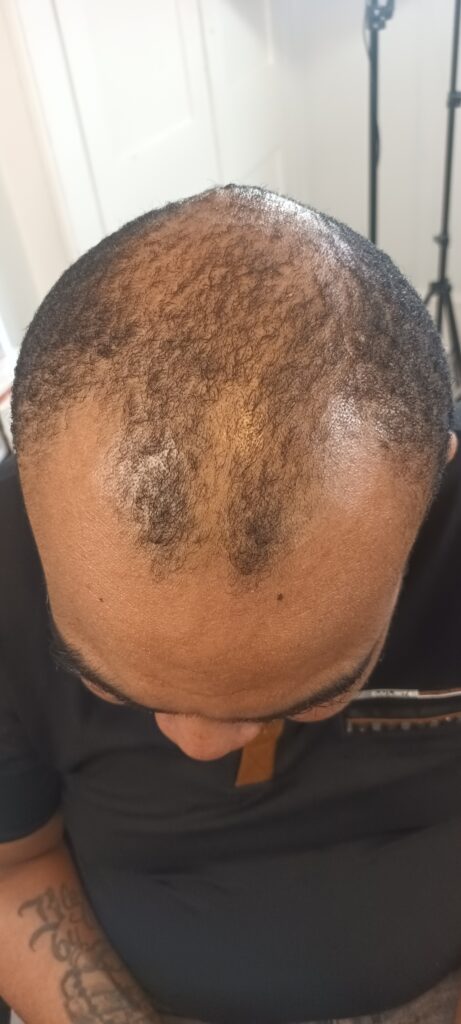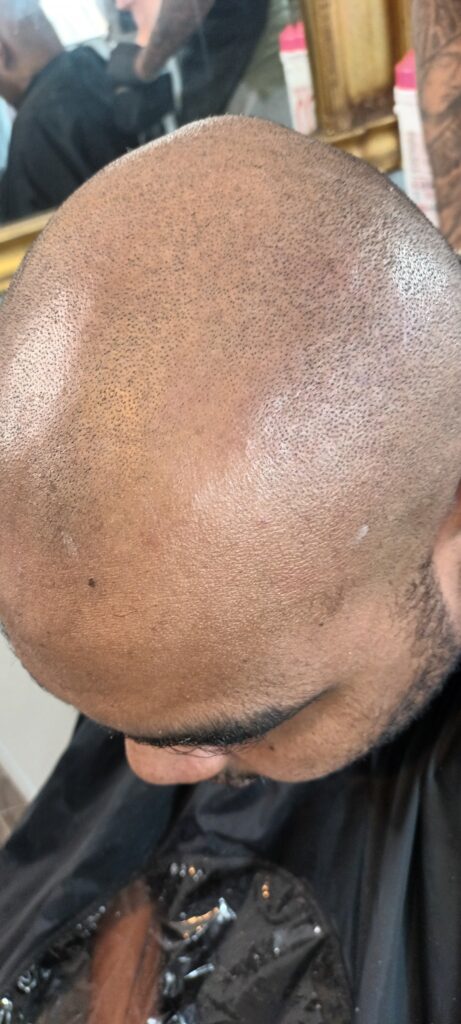Scalp Micropigmentation
Scalp Micropigmentation (SMP) offers a non-surgical solution for individuals dealing with hair loss and thinning hair. This technique involves the application of specialized pigments on the scalp to create the illusion of hair follicles. By strategically placing tiny layers of dots on the scalp, SMP replicates the appearance of natural hair follicles and shadows, giving the impression of a closely shaved head with a buzzed hair look. This treatment is suitable for both men and women. The pigments utilized in SMP are of the highest quality within the industry, composed of natural ingredients, including carbon. They are derived from organic sources, ensuring a natural appearance. Since SMP is a non-invasive procedure, it requires minimal recovery time, and results are immediately noticeable, providing individuals with a natural-looking solution for hair loss and thinning hair.
Who is a good fit for Scalp Micropigmentation?
Scalp Micropigmentation is a suitable option for both men and women who are dealing with various forms of hair loss, including conditions like cancer-related hair loss, alopecia, thinning hair, or male and female pattern baldness.
This procedure is particularly well-suited for individuals who:
- Desire full coverage or the appearance of a closely shaved haircut.
- Seek to conceal scars on their scalp, which can result from burns, injuries, alopecia, or previous FUT/FUE hair transplant surgeries.
- Prefer a low-maintenance solution for hair loss that involves minimal downtime and delivers immediate results.
- Want to enhance the density of their existing hair, creating the illusion of fuller and thicker hair, whether they are men or women.
- Wish to increase density in the area where they have undergone a hair transplant, providing more volume to the transplanted region.
How many sessions does it take?
Scalp Micropigmentation typically requires multiple sessions to achieve optimal results. On average, we suggest undergoing 2-4 sessions, which may vary depending on the severity of hair loss. We usually allow a 2-3 week gap between each session. This break is essential to allow the pigment to settle and heal during the interim, ensuring that we can layer it effectively in the subsequent session. This layering approach enhances the final result, making it appear more authentic and natural.
How long is each session?
The duration of each session varies based on the specific treatment area and typically ranges from 2 to 3 hours. Importantly, there is no recovery period or downtime required following the procedure.
Is it possible to undergo Scalp Micropigmentation following a hair transplant procedure?
This is frequently performed as a complementary treatment after a hair transplant to enhance the overall outcome. Scalp Micropigmentation (SMP) can be employed to increase the density of the transplanted region or conceal any scarring that may have resulted from procedures like FUE (Follicular Unit Extraction) or FUT (Follicular Unit Transplantation). Typically, we recommend waiting for a period of 8-12 months after a hair transplant. This waiting period allows for the maximum growth of the transplanted hair and ensures that the donor area has sufficiently healed before proceeding with SMP.
Is SMP suitable for women?
Certainly! Many women face issues with hair thinning that can lead to the scalp becoming visible. With this technique, we can strategically apply pigments to the exposed areas, creating the illusion of thicker and fuller hair.
Is SMP painful?
During the procedure, you may experience minor discomfort, but we closely monitor your comfort throughout. It’s important to note that we don’t penetrate beyond the second layer of the skin, which means the level of discomfort is lower compared to traditional tattooing.
What should you expect during a consultation at WUWB?
During the consultation, we will evaluate the degree of your hair loss and have a discussion with you regarding your expectations. Subsequently, we will provide you with information about the possible results achievable through the treatment options that are available to you.


